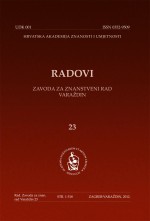FILIĆEV POVRATAK I POVRATAK FILIĆU
FILIĆ’S RETURN AND RETURN TO FILIĆ
Author(s): Dada RužaSubject(s): History
Published by: Hrvatska akademija znanosti i umjetnosti - Zavod za znanstveni rad Varaždin
Keywords: Filić; musical life in Varaždin; Varaždin City Museum; Varaždin Baroque Evenings; period instruments; positive organ; Rapoldt; organ; Freundt; Römer; fortepiano; Rosenberger; Schmidt; Lange; Tafelklavier; Jakesch; musical collection
Summary/Abstract: In 1917 Krešimir Filić returns to war-torn Varaždin from Prague, where he graduated from University. It was in Varaždin that he engaged in intensive activity within the “Tomislav” Academic Society. He would remain active in Varaždin as a professor, geographer, historian, social activist, scientific researcher, writer, enlightening intellectual, museologist, musician and organizer of music events and musical education until his very old age. He was extremely active in the organizations he was a member of. When it was necessary he carried out reforms of the organizations, helped them improve or founded new ones. Many of them flourish even today, such as Pučko otvoreno učilište /Open University/, City Museum, “Ravna Gora” Mountaineering Association, Music School, Varaždin Baroque Evenings. Some of the institutions did not survive, mainly due to a lack of support from the political regime (such as the theatre orchestra, “Vatroslav Jagić” Choral Society, Music Lovers’ Society). He left behind the idea of a music collection of the City Museum, which was not realized. In a 1968 issue of “Vjesnik” he published an article focusing on the achievements in this field, describing the current situation and suggesting future activities. Between 20th and 21st century, following in his footsteps, several restored instruments (Rudolf Rapoldt’s positive organ and Michael Rosenberger’s Hammerklavier), were included in the Museum’s collection and used to be played on at public concerts held at the Varaždin Baroque Evenings. Expert opinions on the other musical instruments of the Museum stock have been provided, and documents have been collected enabling a future restoration. Filić’s idea can be realized by taking further action to have these musical instruments restored, as well as by creating a collection of other exhibits (sheet music, written sources, musical iconography, electronic media contents) thus not only paying him homage, but creating new conditions for further research and creativity in the field of music, science, education, as well as tourism.
Journal: Radovi Zavoda za znanstveni rad Varaždin
- Issue Year: 2012
- Issue No: 23
- Page Range: 199-208
- Page Count: 10
- Language: Croatian

